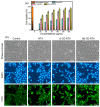Formulation and Characterization of β-Cyclodextrins-Nitazoxanide Inclusion Complexes: Enhanced Solubility, In Vitro Drug Release, and Antiviral Activity in Vero Cells
- PMID: 39771475
- PMCID: PMC11677481
- DOI: 10.3390/pharmaceutics16121494
Formulation and Characterization of β-Cyclodextrins-Nitazoxanide Inclusion Complexes: Enhanced Solubility, In Vitro Drug Release, and Antiviral Activity in Vero Cells
Abstract
Background/Objectives: Nitazoxanide (NTX) exhibits promising therapeutic potential; its effectiveness is constrained by its low oral bioavailability due to its poor water solubility and limited permeability. Methods: This study focused on developing a complex of NTX with β-cyclodextrins (β-CDs), specifically β-CD and hydroxypropyl-β-cyclodextrin (Hβ-CD), to enhance the solubility and antiviral activity of NTX. Results: The formation of the β-CD:NTX in an aqueous solution was verified using UV-visible spectroscopy, confirming a 1:1 inclusion complex. Characterization of the solid β-CD:NTX complexes was confirmed via FTIR, X-ray diffraction (XRD), scanning electron microscopy (SEM), and DSC-TGA analyses. Molecular docking studies revealed that the NTX thiazole ring with the nitro group was positioned within the β-CDs cavity, while the benzene ring remained outside. Phase solubility tests showed that β-CD:NTX complexes were formed with high stability constants, demonstrating a linear increase in NTX solubility as the β-CD concentration increased. Dissolution tests revealed rapid and nearly complete NTX release within 90 min for β-CD:NTX and Hβ-CD:NTX complexes. The β-CD:NTX complexes were tested for their antiviral activity against Herpes simplex virus (HSV-1) cultures. Results showed that the Hβ-CD:NTX complex had significantly higher antiviral efficacy than β-CD:NTX and free NTX alone. Moreover, cytotoxicity and cellular uptake studies on Vero cells indicated that the Hβ-CD:NTX complex demonstrated lower cytotoxicity and had the highest IC50 value, followed by β-CD:NTX and free NTX. Conclusions: These findings suggest that Hβ-CD:NTX inclusion complexes may serve as effective carriers for delivering NTX in HSV-1 treatments using Vero cell models.
Keywords: antiviral activity; in vitro drug release; inclusion complexes; nitazoxanide; solubility; β-cyclodextrins.
Conflict of interest statement
The authors declare no conflicts of interest.
Figures










Similar articles
-
Enhancement of oral bioavailability of cilostazol by forming its inclusion complexes.AAPS PharmSciTech. 2009;10(2):660-9. doi: 10.1208/s12249-009-9249-7. Epub 2009 May 21. AAPS PharmSciTech. 2009. PMID: 19459053 Free PMC article.
-
Physicochemical characterization and in vitro biological evaluation of solid compounds from furazolidone-based cyclodextrins for use as leishmanicidal agents.Drug Deliv Transl Res. 2020 Dec;10(6):1788-1809. doi: 10.1007/s13346-020-00841-1. Drug Deliv Transl Res. 2020. PMID: 32803562
-
Preparation and Characterization of Disulfiram and Beta Cyclodextrin Inclusion Complexes for Potential Application in the Treatment of SARS-CoV-2 via Nebulization.Molecules. 2022 Aug 31;27(17):5600. doi: 10.3390/molecules27175600. Molecules. 2022. PMID: 36080368 Free PMC article.
-
Enhanced Solubility of Albendazole in Cyclodextrin Inclusion Complex: A Molecular Modeling Approach and Physicochemical Evaluation.Curr Drug Deliv. 2022;19(1):86-92. doi: 10.2174/1567201818666210614104234. Curr Drug Deliv. 2022. PMID: 34126897
-
Inclusion complexes of tadalafil with natural and chemically modified beta-cyclodextrins. I: preparation and in-vitro evaluation.Eur J Pharm Biopharm. 2008 Nov;70(3):819-27. doi: 10.1016/j.ejpb.2008.06.024. Epub 2008 Jul 4. Eur J Pharm Biopharm. 2008. PMID: 18655829
References
Grants and funding
LinkOut - more resources
Full Text Sources

